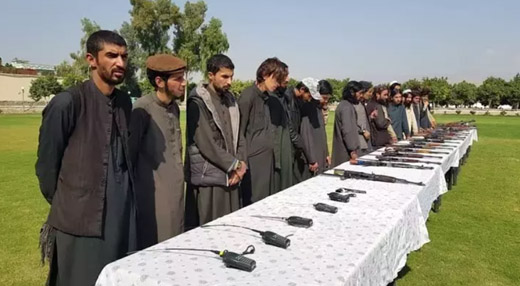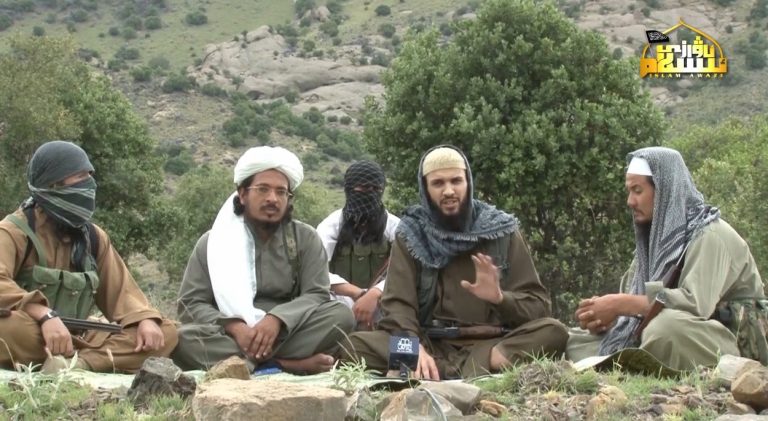By Hossain Ehsani: Researcher on Islamic Fundamentalist Groups
Shrine of Shah Cheragh in Iran has come under attack by Islamic fundamentalist forces for the second time. The notable distinction between the recent assault and the previous one lies in the silence of propaganda channels associated with Islamic fundamentalist groups. The fundamental question here is which group has once again targeted the Shah Cheragh shrine. This commentary seeks to delve into the potential perpetrators of the recent attack on the shrine and address the question: Is post-collapse Afghanistan a source of escalating threats toward Iran?
According to Iranian government sources, on August 13, 2023, a fighter affiliated with Islamic fundamentalism named Rahmatullah Navrozov, also known under the pseudonym Salman Aslamyar, hails from Badakhshan province of Tajikistan. He joined ISIS in Turkey and underwent three months of military training in Afghanistan. However, the extent to which this account aligns with the realities on the ground and Afghanistan’s security dynamics remains uncertain from three main perspectives: logistical preparations, organizational communications, and internal conflicts within the Taliban network post-collapse of the former government in Afghanistan.
From Turkey to Badakhshan and Logistical Routes:
The presence of foreign fighters from the Islamic State of Iraq and Syria (ISIS) and other terrorist groups in Afghanistan is neither sudden nor coincidental. This process commenced when a significant portion of Uzbek and Tajik fighters from Jabhat al-Nusra (also known as Hayat Tahrir al-Sham) returned to northern Afghanistan following successive defeats against ISIS in the years of conflict between ISIS and Jabhat al-Nusra in Iraq and Syria. These fighters established their logistical route from Idlib, Syria, to the city of Van in Turkey. Subsequently, they traversed a route spanning Urmia, Zanjan, Qazvin, Tehran, Birjand, Zahedan, and finally Nimruz, and from there, they were transferred to northern regions of Afghanistan.
The writer [of this investigative report], to complete a book about the Islamic State of Khorasan Province (IS-K), conducted interviews with fighters affiliated with the ISIS Khorasan (IS-K) in various prisons of the previous government of Afghanistan. An Iranian ISIS fighter, held in the custody of the former Afghan National Directorate of Security (NDS), revealed that he had been recruited through ISIS propaganda channels on Telegram in the province of Urmia. He then followed the same communication route, with the assistance of an individual named Abu Ahmad, to reach Afghanistan. Amin Delneshin recounted receiving an Afghan passport and National Identity Card (NIC) near the Nimruz border from Abu Ahmad. [1] Farhad, a Tajik fighter of the ISIS Khorasan (IS-K), stated that he had traveled this same route within Iran, but entering Herat via the Islam Qala border crossing.


Three other Jordanian ISIS Khorasan (IS-K) fighters also claimed in an interview with Al Jazeera that after escaping to Urmia, they joined the ranks of Uzbek and Tajik fighters. Subsequently, upon their arrest by Iranian security forces, these three Jordanian individuals asserted that they are Uzbek Nationals. Therefore, Iranian forces, alongside other fighters, transported them to the borders of Afghanistan.

A Kazakh woman detained in the former government of Afganistan’s National Directorate of Security (NDS) prison had stated that she initially traveled from Kazakhstan to Cairo, and then from Cairo to Tehran. There, after becoming acquainted with her jihadi husband, they journeyed to Nangarhar province in Afghanistan using Afghan National Identity Cards (NICs) and passports.
Iran’s involvement as a conduit for threats from Syria and Iraq to Afghanistan hasn’t been a one-sided matter. Numerous jihadist fighters have traversed Iran to reach conflict zones under the purview of ISIS in Syria and Iraq. For instance, a person named Gala Khan Hamidi, listed in the U.S. Department of Treasury’s sanctions list acted as a facilitator connecting the Haqqani network with central ISIS. According to the U.S. Department of Treasury report, Hamidi facilitated the travel of an Uzbek fighter from Pakistan to Turkey in 2014, smuggled certain Afghan extremists from Afghanistan to Europe via coordination with an Iranian smuggler in 2017, and enabled the travel of Al-Qaeda members and the Tehrik-i-Taliban Pakistan (TTP) through Iran to Turkey in 2014.
Additionally, a senior leader and preacher of the Islamic Movement of Uzbekistan (IMU), named Yassin Chouka, a German national using the pseudonym Abu Ibraheem, attempted to travel to Syria via Iran in 2014. Some German authorities stated that they were informed about his death at an Iranian border crossing during his exit from Iran. However, his demise has not been officially confirmed by the IMU, Iranian authorities, or Germany.

This communication route has been in service to the forces of Al-Qaeda and Camp Tawhid and Jihad after the coalition forces, led by the United States, entered Afghanistan in 2001. Abu Musab al-Zarqawi, for instance, reached northern Iraq via Iran after the bombing of Camp Tawhid and Jihad. Similarly, Mullah Karekar known as Kurd Bin Laden, a renowned member of Al-Qaeda, resided in the areas of Uramanat and Kamyaran for years.
It appears that Aslamyar, upon joining the Islamic State of Iraq and Syria (ISIS) in Turkey, followed this same communication route to Afghanistan for military training. However, the ambiguous question remains as to why Iranian security authorities were unaware of the movements of this fighter and the individuals involved in the previous Shah Cheragh incident. Additionally, it seems that fundamentalist jihadists are not capable of traveling between cities and borders without the approval of Iranian security officials. The reason behind Iranian authorities facilitating the transit of these fighters remains unclear.
Iran hasn’t solely served as a communication hub for Islamic fundamentalist fighters traveling between Afghanistan and conflict zones in Arab regions and vice versa. It has also acted as a refuge for these fighters, serving as a base for planning various attacks in contested areas. A senior intelligence official from the former Afghan government, on the condition of anonymity, stated, “The lead on the attack on 50-Bed Hospital in Dasht-e Barchi of Kabul on May 12, 2020 leads to Tehran.” Another senior intelligence official from the former Afghan government, also on the condition of anonymity, added, “The planners of this attack were members of ISIS. Two of them were working in a furniture factory in the Yaft Abad neighborhood of Tehran, and another one had a duty in a supermarket in the 18th district of Tehran.”
Tajik Fighters and the Taliban:
If the confessions published by Iranian media sources are accurate, stating that Aslamyar went to Afghanistan for military training and subsequently, after three months of military training, returned to Iran to attack the Shah Cheragh shrine, then these confessions encounter challenges both ideologically and structurally.
From an ideological standpoint, the Islamic State organization requires purifying society of impurities and eradicating the fundamental causes of societal weakness to establish an Islamic caliphate. Thus, the elimination of these impurities within society is necessary to create the conditions for the formation of an Islamic state. Accordingly, the ISIS Khorasan (IS-K) views the Taliban as a deviant, infidel force manipulated by the West, considering the fight against it as one of its priorities. Therefore, from an ideological perspective, the presence of Rahmatullah Navrozov in Afghanistan should align with the path of fighting the Taliban, not undertaking widespread military training in their controled region. This is because, according to jihadist Salafi thought, conflict zones serve as places of jihad, not spaces for comprehensive military and armament training. [2] Based on this foundation, his presence in Afghanistan without engaging in the fight against the Taliban is deemed an un-Islamic act that contradicts Jihadist ideology.
A structural challenge arises from the fact that Rahmatullah Navrozov, as a Tajik jihadist, should operate in regions where there is at least a Tajik leadership or command structure. The dispersion of Tajik ISIS forces in northern Afghanistan is evident, where the influence of Qari Fasihuddin, the Chief of the General Staff of the Armed Forces of the Taliban, is palpable. Following various attacks by the ISIS Khorasan (IS-K) in Badakhshan province of Afghanistan, he has shown a particular focus on countering ISIS. In this context, how could the forces under Qari Fasihuddin’s leadership fail to monitor and identify the military training facility where Aslamyar received his training, potentially leading to its destruction?
It appears that more than being influenced by the Islamic State organization, Rahmatullah Navrozov might have stronger organizational ties with the Taliban’s Tajik faction or the Ansarullah group. The Taliban’s Tajik faction, led by Mehdi Arsalan, has been active in significant activities in northern Afghanistan and controls certain areas. Traditionally, in addition to its actions against the Tajik government, Ansarullah has engaged in fights side by side to Qari Fasihuddin’s forces in the districts of Kofab, Shiki, Miyami, and Nasi, against the former government of Afghanistan, and has secured prominent security positions in the north after the fall of the previous Afghan government. Their influence has notably solidified in the northern geography of the country.
Internal Disputes Within the Taliban:
According to media reports, the presence of advisors from the Islamic Revolutionary Guard Corps (IRGC) in Kandahar province, the base of Hibatullah Akhundzada is significant. These forces aim to provide their intelligence consultations to the Taliban supreme leader to advance the group’s objectives. The presence of these advisors in Kandahar has led to discontent among certain factions inside the Taliban, including Sirajuddin Haqqani, who has expressed his dissatisfaction in various speeches using different approaches.
It might seem that the Haqqani network is seeking revenge for the extensive presence of senior IRGC advisors in Kandahar, which guides the Hibatullah faction in enhancing and expanding its power. For this reason, field sources in western parts of Afghanistan have reported that a portion of the process of Waziristanization in the western region of Afghanistan is being carried out by the Haqqani network. This effort is being composed of both Pakistani Taliban Tehrik-e-Taliban Pakistan (TTP) fighters and other non-Taliban combatants. However, it’s possible that the Haqqani network, in collaboration with Qari Fasihuddin, has launched threats towards Iran intending to seek revenge against the Islamic Revolutionary Guard Corps (IRGC). It’s worth noting that Qari Fasihuddin became the deputy of the military commission of the Peshawar Council when this commission integrated with the Haqqani network, conducting joint plans and operations in various parts of Afghanistan.
Therefore, the perpetrator of the attack on the Shah Cheragh shrine for the second time, rather than indicating the involvement of this fighter with ISIS, demonstrates more organizational alignment with the evidence on the ground, pointing towards the Taliban of Tajikistan. Given the lack of acceptance of responsibility for the attack on the Shah Cheragh shrine by the Islamic State of Iraq and Syria (ISIS), this assumption becomes more likely. If this assumption holds, it seems that the overflow of threats from jihadist fighters in Afghanistan to Iran will become a perilous matter, turning Afghanistan under Taliban rule into a source of threat to Iran. On the other hand, this contradicts the Doha Agreement and Afghanistan under Taliban rule has transformed into a source of threat to Iran. This assumption has been substantiated in the past with repeated border attacks and territorial conflicts in eastern regions of Iran, water rights issues, and the attack by an Afghan Uzbek jihadist on the shrine of Ali ibn Musa al-Ridha in Mashhad. The extent, scope, and magnitude of this threat are yet to be determined.
[1] Washington, Shan, Ehsani, Hossein, (2020) Islamic Emirate of Khorasan Government, Printed Version, Institute of Strategic Studies of Afghanistan, Kabul, Afghanistan
[2] Naji, Abu Bakr (2004) The Management of Savagery: The Most Dangerous Phase the Nation Will Go Through











